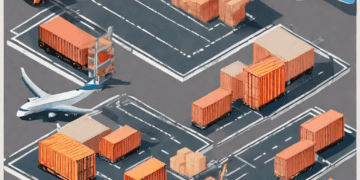The Indian freight forwarding sector is experiencing substantial growth due to increased integration into the global economy, alongside domestic improvements in production and consumption patterns. Notably, India’s robust trade figures, with exports reaching US$417.8 billion and imports hitting US$610 billion in FY 2021-22, signify the immense trade volume and consequently, the escalating demand for logistics services. This surge has bolstered the growth of the Indian freight forwarding industry.
As corporations increasingly concentrate on their core operations, the outsourcing of supply chain distribution to intermediaries has amplified the need for freight forwarders who operate in a cost-effective manner. Additionally, factors such as burgeoning digitization, evolving consumer preferences, the expansion of e-commerce, and supportive government policies like the National Asset Monetization Pipeline and PM Gati Shakti Yojana are steering the metamorphosis, modernization, and expansion of the logistics sector in India.
Understanding the Role of Freight Forwarders
Freight forwarders serve as vital intermediaries in the supply chain, facilitating the movement of goods from the sender to their final destination. Although they do not physically transport the shipments, they coordinate various modes of transportation, including sea/ocean freight, rail, road, and air shipments. These forwarders often utilize multiple transportation modes for a single consignment to ensure efficient delivery.
Initially engaged primarily in transportation logistics (2PL), freight forwarders have expanded their services to encompass international shipments, including activities like packaging, documentation, warehousing, inventory management, and value-added services (VAS). In this expanded role, they are known as third-party logistics providers (3PL).
Insight into the Freight Forwarding Process
The freight forwarding process comprises several stages:
Export haulage: Transfer of goods from the manufacturing location to the freight forwarder’s warehouse. Export customs clearance: Obtaining clearance for shipment. Origin handling: Validation of cargo against booking documents. Import customs clearance: Unloading and customs paperwork for incoming cargo. Destination handling: Management of the shipped goods upon arrival at the destination, including transfer to the import warehouse. Import haulage: Final delivery of goods from the import warehouse to the buyer’s location.
This process necessitates various documents, including commercial invoices, packing lists, export shipping bills, certificates of origin, letters of credit (if applicable), insurance certificates, bills of lading, and declarations for hazardous cargo (if applicable).
Establishing a Freight Forwarding Unit in India
Setting up a freight forwarding unit in India involves several key steps:
Step 1: Determining the Business Model Entrepreneurs initiating a freight forwarding unit must decide on the business model aligned with their corporate strategy and long-term objectives. They can either start an independent venture or opt for acquiring a franchise. Selecting the appropriate business entity structure is crucial, considering factors like tax implications, compliance burden, investment, and exit strategy.
Options for business structures include Sole Proprietorship, Partnership Firm, Limited Liability Partnership (LLP), Private Limited Company, Public Limited Company, and One Person Company (OPC). Each structure has its own merits and considerations regarding liability, ownership, and compliance requirements.
Step 2: Obtaining Mandatory Compliances To operate a freight forwarding business in India, obtaining specific licenses is essential. These include the International Air Transport Association (IATA) License for international operations and the Air Cargo Agent Association of India (ACCAI) license. Additionally, registrations with the Tax Department, Directorate General of Foreign Trade (DGFT), Registrar of Companies, and GST are mandatory.
The freight forwarding industry’s Outlook and Regulatory Framework
The Indian logistics market was approximately US$250 billion in FY 2020-21, projected to reach US$380 billion by 2025, fueled by digitization and post-pandemic growth estimated at a CAGR of 10-12 percent. Technological advancements, infrastructure development, and trends like digital freight booking platforms (“Uber for freight”) are reshaping the industry.
India’s infrastructural connectivity programs, including freight corridors, Sagarmala, and Bharatmala, have bolstered the logistics landscape. The integration of technology like IoT, automation, blockchain, cloud computing, big data analysis, AI, and robotics is expected to further drive efficiency and cost reduction.
The regulatory landscape governing freight forwarders in India encompasses statutes like the Multimodal Transportation of Goods Act, various Acts for land, sea, and air transport, and the Warehousing (Development and Regulation) Act, 2007. The upcoming Draft National Logistics Policy aims to mitigate supply chain bottlenecks and create an integrated logistics ecosystem to reduce logistics costs from 14 percent to 10 percent of GDP.
Get the latest supply chain logistics news updates at The Supply Chain Report. Visit ADAMftd.com for free tools related to international trade.
#IndianFreightForwarding #GlobalEconomyIntegration #LogisticsIndia #FreightForwarders #SupplyChainIndia #IndianTradeGrowth #ECommerceLogistics #DigitalFreightIndia #PMGatiShakti #AssetMonetizationPipeline #ModernLogistics #FreightCorridors #SagarmalaProject #BharatmalaProgram #NationalLogisticsPolicy #3PLIndia #TechInLogistics #IoTInLogistics #AIInSupplyChain #BlockchainInLogistics

















